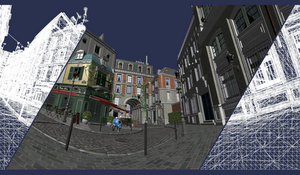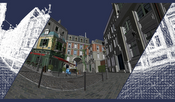Information
- Publication Type: Master Thesis
- Workgroup(s)/Project(s):
- Date: January 2023
- Date (Start): October 2021
- Date (End): January 2023
- Diploma Examination: 18. January 2013
- Open Access: yes
- First Supervisor:
- Pages: 102
- Keywords: Distortion Compensation, Curved Monitors, Projection, Real-Time Rendering, Vulkan, C++, Auto-Vk, Auto-Vk-Toolkit, Non-Linear Projections, Perspective-Correct Rendering, Graphics Mesh Pipeline, Mesh Shaders, Grid-Based Triangle Subdivision, Head Tracking
Abstract
In recent years, curved computer monitors have become a viable option for consumers. However, traditional real-time graphics pipelines expect a flat display surface, and most real-time applications, such as games and simulations, do not consider the actual geometry of the monitor during rendering. As a result, the synthesized images appear distorted and unnatural when viewed on a curved display. Distortion correction methods for correcting the lens distortion in cameras and head-mounted displays can also be utilized in real-time rendering software for curved monitors. However, the final distortion observed on the curved display depends on the user's viewpoint. With head-tracking, accurate distortion correction can be performed, and perspective-correct projections can be produced. In this thesis, we analyze various methods for generating correct renderings based on the user's viewpoint and the geometry of the monitor. Our experiments confirm that image-based methods provide the best overall performance with acceptable image quality. However, real-time ray tracing and geometry-based implementations are practicable alternatives when using current hardware, and these methods do not suffer from image resampling artifacts. Additionally, we present and evaluate a custom subdivision scheme as an alternative to hardware tessellation for geometry-based solutions that can be implemented in a single render pass using the recently introduced graphics mesh pipeline. In our subdivision scheme, the geometry is split along a screen-aligned grid that reflects the geometry of the display more accurately than the fixed tessellation patterns of hardware tessellation. While the performance of our software-based subdivision scheme has to be improved further, it produces fewer triangles for coarse geometry and, at the same time, achieves similar image quality to hardware tessellation.
Additional Files and Images
Additional images and videos
Additional files
Weblinks
BibTeX
@mastersthesis{rumpler-2023-dcmcm,
title = "Real-Time Distortion Correction Methods for Curved Monitors",
author = "Wolfgang Rumpler",
year = "2023",
abstract = "In recent years, curved computer monitors have become a
viable option for consumers. However, traditional real-time
graphics pipelines expect a flat display surface, and most
real-time applications, such as games and simulations, do
not consider the actual geometry of the monitor during
rendering. As a result, the synthesized images appear
distorted and unnatural when viewed on a curved display.
Distortion correction methods for correcting the lens
distortion in cameras and head-mounted displays can also be
utilized in real-time rendering software for curved
monitors. However, the final distortion observed on the
curved display depends on the user's viewpoint. With
head-tracking, accurate distortion correction can be
performed, and perspective-correct projections can be
produced. In this thesis, we analyze various methods for
generating correct renderings based on the user's viewpoint
and the geometry of the monitor. Our experiments confirm
that image-based methods provide the best overall
performance with acceptable image quality. However,
real-time ray tracing and geometry-based implementations are
practicable alternatives when using current hardware, and
these methods do not suffer from image resampling artifacts.
Additionally, we present and evaluate a custom subdivision
scheme as an alternative to hardware tessellation for
geometry-based solutions that can be implemented in a single
render pass using the recently introduced graphics mesh
pipeline. In our subdivision scheme, the geometry is split
along a screen-aligned grid that reflects the geometry of
the display more accurately than the fixed tessellation
patterns of hardware tessellation. While the performance of
our software-based subdivision scheme has to be improved
further, it produces fewer triangles for coarse geometry
and, at the same time, achieves similar image quality to
hardware tessellation.",
month = jan,
pages = "102",
address = "Favoritenstrasse 9-11/E193-02, A-1040 Vienna, Austria",
school = "Research Unit of Computer Graphics, Institute of Visual
Computing and Human-Centered Technology, Faculty of
Informatics, TU Wien",
keywords = "Distortion Compensation, Curved Monitors, Projection,
Real-Time Rendering, Vulkan, C++, Auto-Vk, Auto-Vk-Toolkit,
Non-Linear Projections, Perspective-Correct Rendering,
Graphics Mesh Pipeline, Mesh Shaders, Grid-Based Triangle
Subdivision, Head Tracking",
URL = "https://www.cg.tuwien.ac.at/research/publications/2023/rumpler-2023-dcmcm/",
}

 poster
poster thesis
thesis


